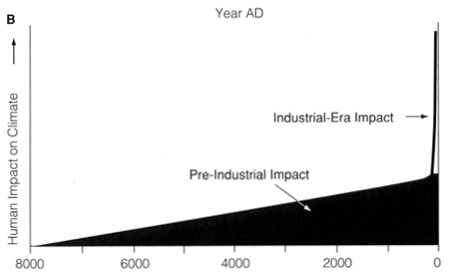

In the near future:
The Neolithic (Agricultural) and Industrial Revolutions
On this scale it is hard to imagine that humans would have much effect on the planetary situation. However, the evidence is strong (we'll
get to the specifics later) that the combination of agriculture (the Neolithic Revolution) and technology (and in particular
the Industrial Revolution) allowed us to be a force to be reckoned with. (Actually, even pre-agricultural humans are implicated
in extinctions of many large-bodied animals around the world at the end of the last glacial cycle!)
Agriculture spread out from the Fertile Crescent to other parts of the Old World, and was independently developed in several other regions. Agriculture has two major consequences for Earth climate systems:
With more and more parts of the Earth converted into regions to fuel more and more humans, the population of our species has
greatly increased:

(note that timescale is not linear, but population size is. World population should reach 7 billion in 2012 C.E.)
Our direct use of wild foods has greatly decreased, at least as regards to terrestrial animals (except for game, which is limited generally to the wilderness of the developing world and sports hunters in the developed world) and plants and fungi. Fishing, however, still has a large wild-based component.
Most of our food now comes from farming. As such, it uses a substantial fraction of the planet's surface. Large scale farming to support the cities of the world necessarily requires industrial farming equipment and chemical fertilizers (in order to allow a small fraction of the population to feed the rest).
Farming allowed for a tremendous increase in population, and allows us to capture progressively more and more of the planetary biomass to feed our species. Additionally, much of energy consumption has to do with growing and transporting food stuffs.
One of the most important nutrients that farming exhausts from the soil is nitrogen. While in older societies natural sources of nitrogen were used (guano from bats and birds; sal ammoniac; etc.), the Haber-Bosch process (developed in 1908) allows us to artificially generate ammonia. Via the Haber-Bosch process, humans generate about 100 Tg of nitrogen per year for agriculatural use, increasing yields such that where one acre used to support 1.9 people it now supports 4.3.
Supported by the products of farming, agricultural societies could afford to have specialists in metallurgy, pottery, and eventually more advanced forms of engineering. By the late 1700s and early 1800s C.E. Scottish engineers were uniting steam engines fueld by coal with steel-framed machines, leading to the Industrial Revolution. With coal-buring steam power (eventually assisted by petroleum- and methane-fueled internal combustion engines) it became far easier to farm; to transport huge amounts of material; to dig up and build on tracts of land; etc.)
As we saw last semester, however, such large-scale operations of fuel burning releases copious amounts of greenhouse gasses (about 7.9 Gt C
in 2009) into the atmosphere, among many other changes. The scale at which humans now release greenhouse gasses, fix nitrogen, produce
erosion, consume nutrients, and so forth is on a scale with planetary geological forces:

Some researchers have suggested that we have now entered the Anthropocene Epoch: a new phase of geologic time in which humans
represent a geologic force. I personally disagree with using this term as a geologic time period: we have a perfectly good term (Holocene Epoch)
for the last 11.7 ka, and when we get into shorter term time units we actually have good calendar systems and such! Additionally,
as we will see later on, the current situation is not sustainable at anything like geological time scales, and so the "Anthropocene"
repesents an event (like the Paleocene-Eocene Thermal Maximum or the Permo-Triassic Extinction) rather than a period. Furthermore,
it isn't entirely certain if the Anthropocene should be started with the Industrial Revolution (as typically used) or if (as William
Ruddiman of the University of Virginia argues) methane and carbon dioxide produced by early agriculturalists had a slow but steady
contribution, and thus it began with the Neolithic Revolution:

We aren't going to quibble over this here. Regardless of when and to what degree it began, we do live in a world in which human activity is one of the primary drivers of climate and change. We are definitely in the Anthropocene; it is now our job to understand what that means.
Some have suggested that once humans began to modify terrestrial climates and ecosystems to a great degree that the Earth left the Holocene and entered the Anthropocene. However, although it is important to recognize humanity's impact on the planet, it is unlikely that this will last for a geologically long duration worthy of an Epoch! More likely it will be comparable to shorter-scale events (like the Paleocene-Eocene Thermal Maximum).
Longer term changes:
To Previous Lecture.
To Syllabus.